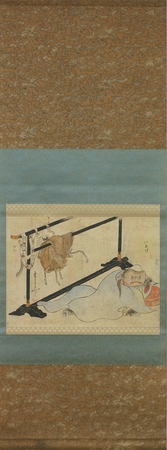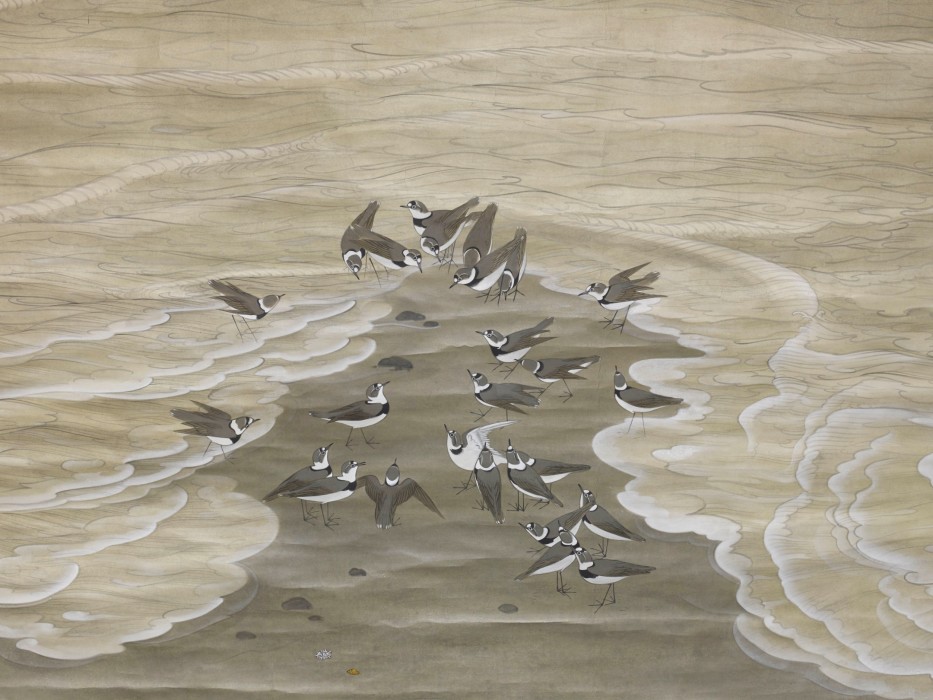Product Description
7186 Takaku Ryūko (1810-1858)
A paper kakemono (hanging scroll) painted in ink and colour on paper with three bakemono (shapeshifters) and a kimono rack. The obi (sash) is transforming into a snake, the kimono into a deer and under a blue kimono is a clawed beast with a hibachi (brazier) for a head. Notes of colours to be used are inscribed on the painting.
Signed: Mudō isshi Ryūko
Seal: Ryūko
Japan 19th century Edo period
Dimensions:
Scroll: H. 43½” x W. 16″ (110cm x 40.5cm)
Painting: H. 10½” x W. 14¾” (26.5cm x 37cm)
Tomobako (original box) inscribed:
Lid: Takaku Ryuko e (Painting by Takaku Ryuko)
Label on lid interior: No 95 and faded collector’s seal
Label: Takaku Ryuko chinga. Bakemono (a rare painting by Takaku Ryuko. Shapeshifters)
Born in Saitama into the Kawakatsu family of samurai, Ryūko’s father was a man of refined style who took up waka poetry and calligraphy as a past time after his retirement and influenced all of his children who were equally interested in the arts.
Ryūko grew up in this inspiring environment and from a young age aspired to become a painter. Ryūko was not interested the traditional accomplishments of a samurai such as chivalry and swordsmanship. This was a great disappointment to his parents and he was disinherited and sent to Edo (Tokyo) where he had the opportunity to study Nanga painting under Yoda Chikkoku (1790-1843).
In 1832 he became fascinated by the work of Yamato-e style painter Tanaka Totsugen (1767-1823) and decided to move to Kyoto and study under him. Nevertheless, Totsugen died soon after Ryūko’s arrival and Ryūko was consequently taught by Totsugen’s disciple Ukita Ikkei (1795-1859). During this period he studied passionately by copying old paintings and sculptures kept by the numerous shrines and temples of Kyoto. In 1836 he toured Nagoya and continued his painting studies under Watanabe Kiyoshi (1778-1861).
Upon his return to Edo in 1838 the differences between his parents and himself had been resolved and he also managed to gain financial support from the wealthy merchant and painting collector Kikuchi Tanga (1796-1843). Ryūko was also part of the artistic circle of the influential Nanga painter Tani Buncho (1763-1840) and was offered to take over the lineage from Buncho’s best student Takaku Aigai (1796-1843) after his death.
Works by the artist can be found in the collections of: Shimada City Museum, Ibaragi Perfectural Museum, Shirakawa City Historical Archives, Tawara City Museum, Fukushima Prefectural Museum, Tokyo University of Art Museum.
Yōkai, bakemono or obake are goblins of a preternatural character in Japanese folklore who have taken on a temporary transformation. Yōkai and bakemono appear in both nonhuman and humanoid forms with the nonhuman types taking even the form of sounds, wind and flames. The humanoid forms are generally of a monstrous appearance often having features –three eyes are one example- which make them less easily associated with humans. Many of the prototypes for these ghosts and monsters came to Japan from China, where for centuries people living beyond China’s borders were described and visually depicted as monsters.
Although often terrifying and sometimes malevolent, yōkai and bakemono are generally not considered pestilential or a threat to societal order. Rather, they are fantastical and scary beings or phenomena that manifest themselves, both indoors or out, primarily at dusk. Numerous types of yokai and bakemono exist in Japanese folklore and often appear in art.









